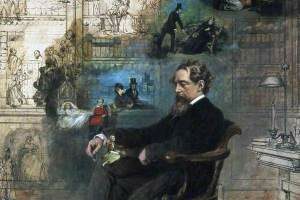 Charles Dickens (Charles John Huffam Dickens) was born in Landport, Portsmouth, England on February 7, 1812 . Charles was the second of eight children to John Dickens – a clerk in the Navy Pay Office – and his wife Elizabeth Dickens. The Dickens family moved to London in 1814, and two years later to Chatham, Kent, where Charles spent early years of his childhood. However, due to the financial difficulties, they moved back to London in 1822, where they settled in Camden Town, a poor neighborhood of London.
Charles Dickens (Charles John Huffam Dickens) was born in Landport, Portsmouth, England on February 7, 1812 . Charles was the second of eight children to John Dickens – a clerk in the Navy Pay Office – and his wife Elizabeth Dickens. The Dickens family moved to London in 1814, and two years later to Chatham, Kent, where Charles spent early years of his childhood. However, due to the financial difficulties, they moved back to London in 1822, where they settled in Camden Town, a poor neighborhood of London.
The defining moment of Dickens’s life occurred when he was 12 years old. His father, who had a difficult time managing money and was constantly in debt, was imprisoned in the Marshal Sea debtor’s prison in 1824. Because of this, Charles was withdrawn from school and forced to work in a warehouse that handled “blacking” – or shoe polish – to help support the family. This experience had profound psychological and sociological effects on Charles: it gave him a firsthand experience with poverty and made him the most vigorous and influential voice of the working classes in his age.
After a few months, Dickens’s father was released from prison and Charles could go back to school. At fifteen, his formal education ended and he found employment as an office boy for an attorney while he studied shorthand at night. From 1830, he worked as a shorthand reporter in the courts and later as a parliamentary and newspaper reporter.
In 1833 Dickens began to contribute short stories and essays to periodicals – newspaper and magazine-like publications. “A Dinner at Popular Walk” was Dickens’s first published story. It appeared in the Monthly Magazine in December 1833. In 1834, he adopted the soon-to-be famous pseudonym “Boz,” under which he released his first book, a collection of stories titled Sketches by Boz, in 1836. In the same year, he married Catherine Hogarth, daughter of the editor of the Evening Chronicle newspaper. Together they had 10 children before they separated in 1858.
Although Dickens’s main profession was as a novelist, he continued his journalistic work until the end of his life, and his connections to various magazines and newspapers gave him the opportunity to begin publishing his fiction at the beginning of his career.

Buss, Robert William; Dickens’s Dream; Charles Dickens Museum, London; http://www.artuk.org/artworks/dickenss-dream-191221
In 1842, Dickens traveled with his wife, Catherine, to the United States and Canada, which led to his controversial “American Notes” (1842) and was also the basis of some of the episodes in Martin Chuzzlewit. Dickens’s series of five Christmas Books followed soon after, the most famous being A Christmas Carol (1843). Dickens continued his success with the largely autobiographical David Copperfield (1849-50) as well as Bleak House (1852-53), Hard Times (1854), Little Dorrit (1857), A Tale of Two Cities (1859), and Great Expectations (1861).
In the closing years of his life, Dickens worsened his already declining health by giving numerous readings of his work. During a reading in 1869, he collapsed, showing symptoms of a mild stroke. He retreated to his estate at Gad’s Hill and began to work on The Mystery of Edwin Drood, which was never completed.
Charles Dickens died at home on June 9, 1870 after suffering a stroke. Contrary to his wish to be buried in Rochester Cathedral, he was buried in the Poets’ Corner of Westminster Abbey with the likes of the Brontë sisters and Lord Byron. The inscription on his tomb reads: “He was a sympathizer to the poor, the suffering, and the oppressed; and by his death, one of England’s greatest writers is lost to the world.”
